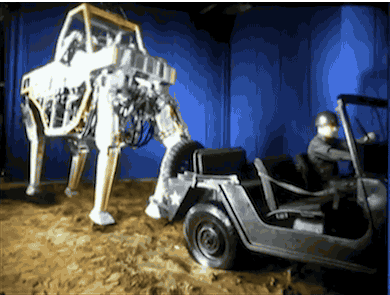In between GE’s clumsy 1968 Pedipulator, an elephant-esque walking truck, and Boston Dynamics’ stunningly agile Big Dog and Cheetah, biomimetics went through plenty of growing pains. It’s a smart concept: Examine how land and marine creatures overcome obstacles and ape it with AI. Easier said than done, though. In “They’re Robots? Those Beasts!” a 2004 New York Times article, Scott Kirsner profiled Northeastern University’s Joseph Ayers and other roboticists exploring nature for inspiration. The opening:
JOSEPH AYERS was crouched over a laptop in a cool cinder block shed barely big enough to house a ride-on lawn mower, watching a boxy-shelled black lobster through a rectangular acrylic window.
Dr. Ayers’s shed is adjacent to a fiberglass saltwater tank that looks like a big above-ground swimming pool, and through the window, he observed as the seven-pound lobster clambered across the sandy bottom and struggled to surmount small rocks.
”He’s pitched backwards onto his tail, and his front legs aren’t really touching the ground,” said Dr. Ayers, a professor of biology at Northeastern University in Boston, sounding vexed.
A few minutes later, Dr. Ayers noticed a screw missing from one of the trio of legs extending from the right side of the lobster’s abdomen. Were this lobster not made of industrial-strength plastic, metal alloys and a nickel metal hydride battery, Dr. Ayers — the author of several lobster cookbooks, including ”Dr. Ayers Cooks With Cognac” — seemed frustrated enough to drop the robotic lobster into a boiling pot of water and serve it up for dinner.
Dr. Ayers was at his university’s Marine Science Center on the peninsula of Nahant, which pokes out into Massachusetts Bay. He was trying to get his robotic lobster ready for a demonstration in late September for the military branch that funds his work, the Office of Naval Research. By then, he hopes to have the lobster using its two claws as bump sensors.
”When it walks into a rock,” he explained, ”it’ll be able to decide whether to go over it or around it, depending on the size of the rock.”
Dr. Ayers is one of a handful of robotics researchers who regard animals as their muses.•



